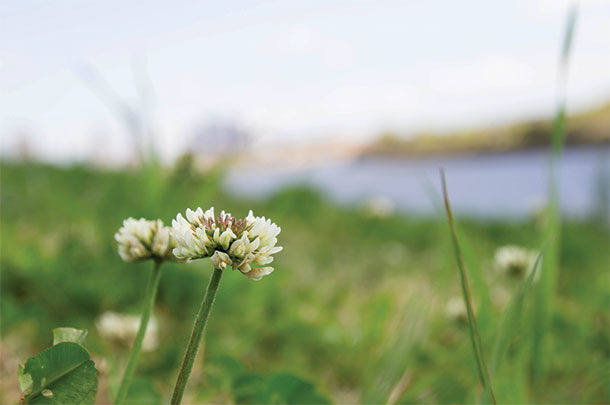These bacteria convert organic nitrogen (N2) – which is a form of nitrogen that plants cannot utilize – into inorganic nitrogen (NH4+) that plants can use. The bacteria benefits from the nutrients in the legumes’ root system, and the legumes benefit from the release of nitrogen from the bacteria.
You may think, “Wow! Free nitrogen. That sounds like a no-brainer. Who doesn’t want free nitrogen fertilizer?” Well, it may be a little more complicated than that.
If a surplus of nitrogen is already available in the soil, adding legumes won’t solicit a noticeable result. But if there is a lack of available nitrogen, then a difference may be observed.
In other words, if you regularly fertilize your pasture with a source of nitrogen and add legumes, the yield may not differ. However, if you never apply nitrogen fertilizer, aside from the manure of grazing animals, you will probably observe a difference after adding inoculated legumes.
Inoculation: Why does it matter?
Unless legumes were already widely dispersed in a pasture recently, it is unlikely that the soil bacteria you need are there to form these mutual relationships. Therefore, the seed you plant needs to be inoculated (treated) with the live bacteria in a stable form. Some legume seed is sold inoculated, but some is not – which means you will need to inoculate it before planting.
This sounds good – tell me about nutritive value
Some common crops that belong to the legume family include alfalfa, clovers, beans and peas. The weed that ate the South, kudzu, is also a legume. In general, legume forages have low fiber content and high protein content. Animal intake on legumes in pasture and on hay is higher than on grasses, and so is digestibility.
With appropriate management, this can equate to an increased rate of growth for livestock and the ability to increase or maintain body condition scores during crucial times. However, consuming too much legume forage can cause bloat due to a lack of adequate fiber.
How much do I need?
Determining the appropriate proportion of legumes to add to a predominantly grass pasture depends on a few factors.
1. Do you plan to renovate the pasture or just add to it?
This will determine how many options you have for seed, your planting methods and the amount of seed you will need. From here on, I will assume we are adding to pastures as they exist.
2. Do you already have some legumes?
If 30 percent or more of your pasture is already composed of legumes, you probably have enough to work with already. If you have some, but less than you would like, managing grazing or cutting height can help you boost the amount of legumes you see.
Most of the grasses that we use in our forages’ systems will grow to higher heights than our legumes. If the canopy above the legumes is too thick, sunlight won’t filter down to the legumes, and this will lead to reduced growth.
Keeping pasture height managed with consideration of both the grasses and legumes should allow both to thrive if all other factors (soil texture, pH, fertility and soil moisture) are adequate.
3. Are you adding annual or perennial legumes?
Annual legumes, like crimson clover, soybean or cowpea, will only persist for that growing season. These legumes typically require more soil preparation and have stricter planting guidelines than perennial legumes, but they pair well with annual grasses and work well in rotation with other annual crops.
Perennial legumes like white and red clover, alfalfa, birdsfoot trefoil, sericea lespedeza and perennial peanut will persist for multiple years and have the potential to spread throughout the pasture by seed, stolons or rhizomes.
Perennial legumes are usually good options for adding legumes to an existing perennial grass pasture. Frost-seeding is a popular method of establishment.
How do I know what legume will work for me?
Species and variety selection is best determined based on your individualized soil tests, pasture maps and management plans. Variety trials are conducted across the country each year, and results are published in unbiased reports that you can access through your local extension office, agricultural co-op, seed dealer and often online from your state’s land-grant university.
These reports will help you identify which species and varieties fit your pasture, as well as provide information on appropriate seeding rates and planting conditions, harvesting techniques and, often, forage quality analysis.
If in doubt, please reach out. There are free services available to help you make a decision based on a plan customized for your specific goals. County extension personnel are one of those services, and we are happy to help you along the way.
Summary
The benefits of adding legumes to your grazed pasture or hayfields are numerous, but there are important factors to consider before you plant the seed. Each situation is slightly different.
Trial and error is the most effective way to learn what works for you, but you can reduce the amount of error you encounter by being fully acquainted with your pastures and developing production goals for your forage and animals. ![]()
PHOTO: Photo licensed through Thinkstock.

-
Christine Gelley
- Extension Educator
- Ohio State University
- Email Christine Gelley











